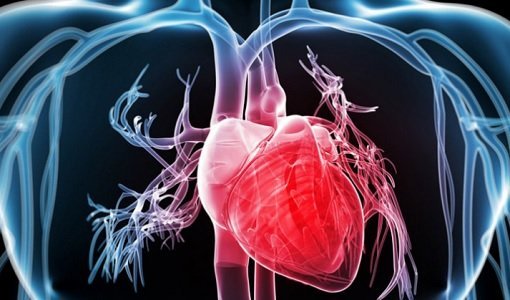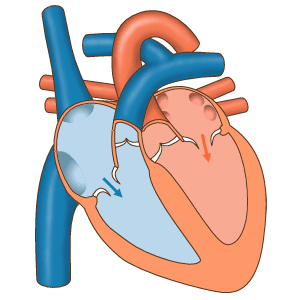Let's talk and know more about the Heart.
An active heart
The heart, the size of a fist, lodges in the chest between both lungs, which partly cover it. He works tirelessly throughout his life to pump blood to the body. It is formed by two muscular pumps joined by their sides. The oxygen-poor blood gets from the tissues and pumps it to the lungs to oxygenate. The left side receives oxygen-rich blood from the lungs and pumps it to the tissues to oxygenate them. The contraction of both pumps is simultaneous within the cycle of three phases of each beat, controlled by a pacemaker.

The interior of the heart
We see here the internal structure of the heart, with its two sides separated by a muscular septum. On each side there are two cameras: The smallest one, above, is the auricula, with thin walls; The biggest one, below, is the vent, with thick walls.
Blood flows to the heart through the atrium; then it passes from this to the ventricles, which pumps it out of it. Cardiac muscle fibers in the walls of the heart are those that produce contractions.

Heart valves
Four valves ensure that blood flows in one direction on each side of the heart, preventing it from flowing back. The bicuspid and tricuspid valves are located between the atria and ventricles, and the sigmoid valves control the exit of the ventricles. When closed, the valves produce in the heart the beats that can be heard with a stethoscope. The biscupide and tricuspid valves produce the most loud and prolonged heartbeat; the sigmoid valves produce the most acute and brief.
Blood flow control
Here we see how the sigmoid valves that control the exit of the left and right vents work. Each valve has cusps in the shape of pockets. When the ventricles contract, the cusps flatten out and blood flows between them at high pressure. When the ventricles dilate, the blood that tends to reflux fills the cusps, which ablates the valves to close.
The ropes
The chordae tendineae of the heart anchor the flanges of the valves to the wall of each ventricul. In the right heart, the tricuspid valve prevents blood from flowing from the ventricle to the atrium.
The bicuspid valve does the same on the left side. When the ventricle contracts, the blood pressure closes the valve. The tendinous cords are tightened to prevent the valves from inverting as an umbrella would.
What a rhythm to follow
The heart has its own pacemaker in the right atrium, which regularly sends electrical signals to its muscle fibers. This establishes the speed of the beats and responds to changes in the component activity. If it fails, you can implant an artificial battery pacemaker whose wires conduct electrical signals to the atrium and ventricle to mark the rate of contraction.
Blood for the heart
The cardiac muscle requires a constant supply of oxygen and nutrients from which to take the energy it needs to contract. The blood circulating in their chambers does not have this purpose, so the blood required by the heart is provided by the blood vessels that we see on the left. The coronary arteries leave the aorta and branch off into capillaries that enter the muscle and then leave it to form veins that eventually discharge into the right atrium.

Congratulations @yulicolmenares! You have completed some achievement on Steemit and have been rewarded with new badge(s) :
Click on any badge to view your own Board of Honor on SteemitBoard.
To support your work, I also upvoted your post!
For more information about SteemitBoard, click here
If you no longer want to receive notifications, reply to this comment with the word
STOPDo not miss the last announcement from @steemitboard!
Downvoting a post can decrease pending rewards and make it less visible. Common reasons:
Submit